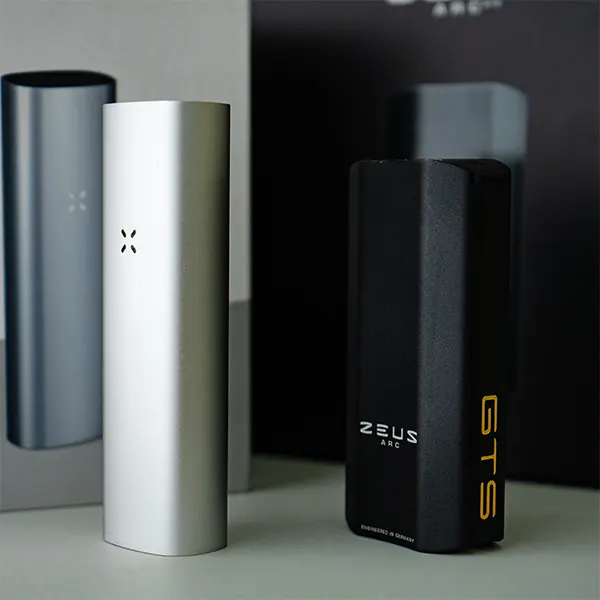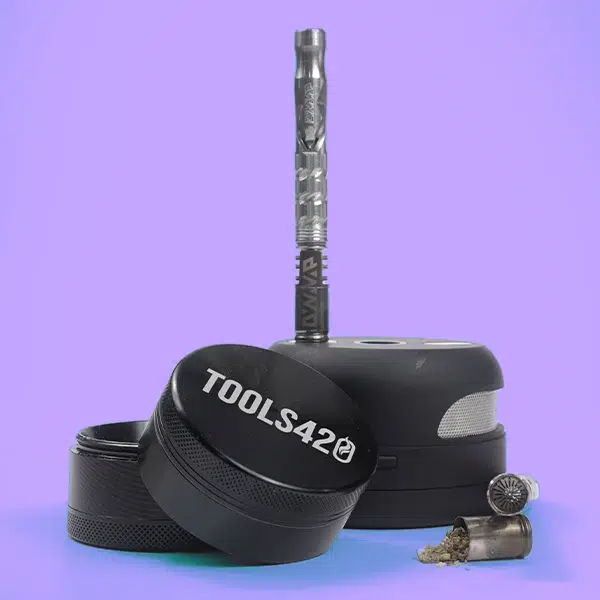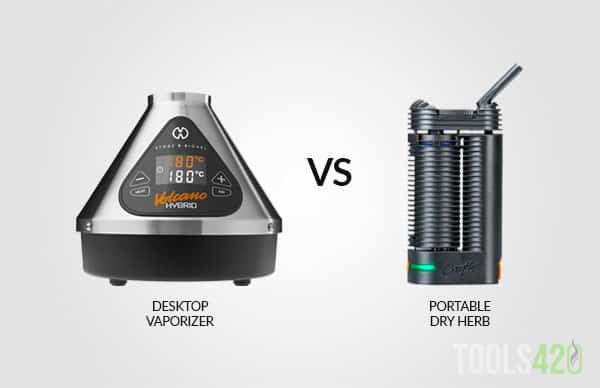A dry herb vaporizer is a device that takes freshly ground bud and brings it right under the burning point, vaporizing off all the delicious cannabinoids and terpenes we’ve come to enjoy! Dry herb vapes come in all shapes and sizes, and even different power sources; some plug into a wall while others use a battery, and some even use a lighter to heat up! Dry herb vapes are not related to e-cig/nicotine vapes at all.
We go over some questions like; what is a dry herb vaporizer, how do they work, differences between conduction vs convection, and if vaping is better in this summary. Check out the best dry herb vape reviews to find out the right ones for you! We go over desktop vaporizers, portable dry herb vaporizers, and all other types as well.
Contents
How does cannabis vaporization work?
Strikingly different than burning the plant, vaporizing extracts all the THC, CBD, and other fun ingredients inside the plant without lighting it on fire. Combustion occurs at roughly 240°C, or 464°F.
Vaporization happens at around 160-230°C or 320-446°F. By boiling off all the cannabinoids and terpenes (the aromatic oils responsible for flavour & smell) without lighting the herb on fire, potency is increased, flavour is more natural, and you avoid unwanted by-products of smoking (such as Carbon Monoxide, and Benzene).

In fact, vaporizing is ~66% more efficient than smoking, since heat isn’t destroying a lot of the THC. This means using less weed in the long term and saving money. You can use that money on a lot of good things, like snacks! Not only is that, but avoiding inhaling smoke is better for the lungs!
The different types of dry herb vaporizer
Just like how there are different ways to smoke; there are also a handful of different ways to vaporize weed. You can use a bubbler/bong, a desktop vape, a portable vaporizer, or even one that uses a torch lighter or candle to heat up.
Most portable dry herb vaporizers are battery powered, are designed for use on the go and to fit in your pocket comfortably. They come in all shapes and sizes – from what looks like a normal e-cig like the Flowermate Slick, a super small and portable herb vape like the Zeus ARC GTS, or strange looking power-tool like the Mighty Plus.

Desktop vapes aren’t limited to using a battery and can give way more power to heat up the herb. Things like the Arizer XQ2 and Volcano Hybrid Vaporizer are very popular and high-quality units. Typically, desktop vapes will perform much better than portable vaporizers, at the cost of portability. If you want to get hit by a truck though, a desktop is the best choice.

Special herb vapes like the ever-popular Dynavap M use a small butane torch lighter to heat up the herb instead of batteries. While these devices have a bit of a learning curve, the power they hold is immense! With great power comes great responsibility, and it’s definitely possible to accidentally combust with these units. Not so practical for on-the-go use, they’re great for at-home portability or if you’ll have some form of privacy when out.

How do cannabis vaporizers heat up?
Among the devices exists three main heating styles; conduction, hybrid, and convection. They each carry some differences. It’s a common dispute; conduction vs convection. Some people strongly prefer convection, while others don’t have a preference. They all provide for slightly different smoking experiences.
A conduction vape works by applying heat directly to the herb, normally with a ceramic or steel heating element. Think of it like cooking bacon on a pan – direct heat. An example of a conduction vape is the DaVinci IQ 2. Typically, conduction vapes cost less, are more portable and discreet, and produce more vapor but lack in flavour.

A convection vape works by applying heat to the herb with hot air. Think of it as cooking a chicken in the oven with hot air. Convection vapes usually heat up a bit slower, provide better flavour, are a bit bulkier, and cost more. An example of a convection vape is the Utillian 722.

A hybrid vape works by applying both heat and hot air to the herb. A hybrid vaporizer sits right in the middle of conduction and convection. It works very well and is the preference for some. An example of a hybrid vape is the Storz & Bickel Crafty+.

While there’s nothing wrong with conduction vaporizers, we find ourselves much preferring hybrid or convection devices. They may cost a bit more, but it’s surely worth it for the improved performance, flavour, and potency!
Desktop vs portable herb vaporizer
Naturally, it makes sense that a unit that plugs into a wall is more powerful. This is true for the most part, and a whole new level of power can be reached. The Volcano Hybrid Vaporizer can load a huge amount of herb in its bowl with nothing that can match its performance or price!
Most people prefer a portable dry herb vape, like the Crafty Plus shown below, since it can be taken anywhere – the park, movie theatres, or a friend’s house. Having to carry a big unit and power cable in search of a power outlet isn’t always so practical.
If you’re a serious stoner, both a portable and a desktop vaporizer might be just the fix since you’ll have both bases covered – a knock-out heavy hitter and a stealthy pocket companion. Start with a portable though if you only want one for now.

Dry Herb Vaporizer Guide Conclusion
We’d be lying if we said we weren’t biased towards vaping! Saving money, being healthier, and staying stealthier are some of our favorite things about weed vapes, and we’re sure you can see why. It’s hard to replace joints and bongs, but with some careful shopping you might come out on top.
It’s best to spend a little more than getting the cheapest herb vape, as the performance upgrade will definitely be worth it and you’ll be less likely to upgrade in the future. Our Top 10 convection vaporizers list is a great place to start, with units of all sizes and prices included.
You’ll end up saving that money in the long term as you’ll use 1/3rd the weed you used to, which you can spend on more weed! Sounds pretty good to me honestly!
